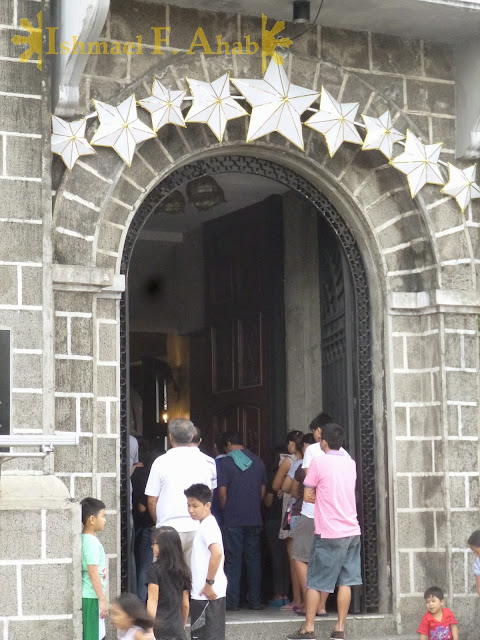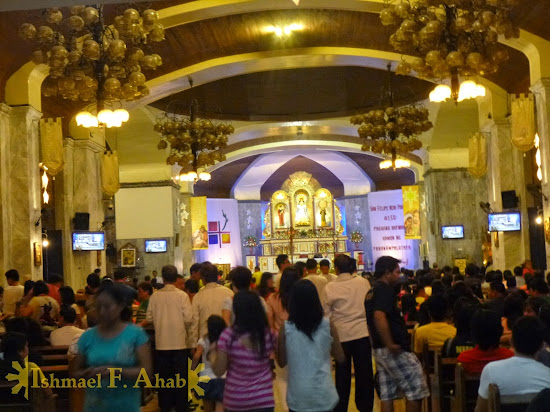There is this church in Manila that I wanted to see again. I could say that “I fell in love” with it the first time I saw it. You could say that it was love at first sight.
I rediscovered this church only this year (after two years of searching for it) when I passed through the district of Sta. Ana for a meeting. The church that I was talking about is the Iglesia de Nuestra Señora de los Desamparados or officially called as the National Shrine of Our Lady of the Abandoned and more popularly known as the Sta. Ana Church.
The National Shrine of Our Lady of the Abandoned is located along [ins street] in Sta. Ana District of Manila. It is just few meters away from Sta. Ana Hospital. Commuters can easily reach it by riding the “Sta. Ana Tulay”-bound jeepneys at Pedro Gil – Taft Avenues.
[ins map]
The district of Sta. Ana was a settlement known as Namayan which was ruled by the Muslim datu, Lakan Tagkan. His domain included the districts of Paco and Pandacan in Manila, Makati, Mandaluyong, and Pasay. Franciscan missionaries came to the area and ask the natives the name of the place. And the answer that they received was “sapa”, which is a Tagalog word for river. The missionaries dedicated the place to Santa Ana, the mother of the Virgin Mary, and they renamed the place as “Sta. Ana de Sapa”.1
Sta. Ana de Sapa was established by Franciscan missionaries in 1578. It is the first settlement that they established outside of Manila or more particularly outside of Intramuros.
The church is being renovated during my last visit. Scaffolds and nets blocked the view of the church’s façade that’s why I didn’t get a good photo of it.
I’m not complaining even though I didn’t have a good photo because the renovation works are important and urgent since old churches like Sta. Ana Church are threatened by earthquakes. The church is too important to our heritage and it should be protected from deterioration.
The construction of Sta. Ana Church started with the laying of cornerstone on September 12, 1720 by Francisco dela Cuesta, who was the Archbishop of Manila and acting Governor General of the Philippines.2
Sta. Ana Church retained its beautiful altar. I’m not sure though if it is the original altar.
The altar displays the images of St. Michael the Archangel, Sts. Peter and Paul, St. Dominic (the founder of the Dominican Order), Sta. Ana, St. John the Baptist, St. John the Evangelist, St. Francis of Assisi, St. Peter Alcantara, St. Bonaventure, St. Bernardine of Siena, and St. Clare.3
Santa Ana Church, as the name suggests, has St. Anne as the patroness. She is mother of the Virgin Mary and also the patron saint of widows, waywards, and happy marriage. However, she was replaced by Our Lady of the Abandoned as the patron saint of Sta. Ana Church in 1720.
The image of Our Lady of the Abandoned standing at the center of the altar was just a replica touched to the original in the metropolitan church in Valencia, Spain. The replica was brought to the Philippines in 1720 by Father Vicente Ingles. Since then, Sta. Ana Church became the center of pilgrimage and devotion to Nuestra Señora de los Desamparados.3
There was a story that Manila Archbishop Pedro de la Santisima Trinidad Martinez Y Arizola is so devoted to Our Lady of the Abandoned that he willed his heart to buried in the church of Santa Ana when he died. His wish was obeyed and now his heart is said to be encased in metal and buried under the altar.3
Another story of devotion is that of Manila Archbishop Francisco dela Cuesta who offered his scepter, which is the symbol of his governorship of the Philippines. His act can be interpreted as a way of giving the whole country under the care of Our Lady of the Abandoned. The crystal scepter is still preserved inside the church.3
I spent some time praying inside Sta. Ana Church. What I like with this church is the relative silence in the place. The church is not too busy unlike the Quiapo Church and Baclaran Church so I was able to pray in silence.
The church interior is simple. There’s no intricate designs, there’s no large painting on the ceiling. The only noticeable artwork inside the church, aside from the altar, is the painting on the side wall.
I don’t know what event is portrayed by the painting. My only guess is that it’s related to an apparition by the Virgin Mary.
There are two peculiar things that I noticed inside Sta. Ana Church. One are the bats that inhabit the church and the other are the grave markers on the floor.
Having a grave inside the church is not actually weird because many old churches in the Philippines have it. Another church that also served as grave is the San Agustin Church located inside Intramuros.
Aside from being the center of faith and one of the remaining Spanish heritage in Manila, Sta. Ana Church also served as a time capsule because many pre-Spanish artifacts were unearthed in 1966 by archeologists from the National Museum.1
 |
| Archaeological diggings at Sta. Ana Church (Source: Sta. Ana Church website) |
As a blogger and Spanish heritage fan, I can say that my visit to Sta. Ana Church is a sort of “mission accomplished”. It’s beautiful altar, it’s classic structure, and it’s archeological importance made my time in this church as well spent.
---
Information contained in this post were obtained from the following sources:
2. Historical marker on the wall of Sta. Ana Church
3. Postings on the bulletin board of Sta. Ana Church
.


















































